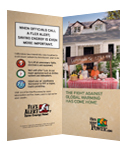Residential Overview > Energy Saving Tips >
Refrigerator Tips
No Cost
- Adjust the refrigerator temperature settings. Optimum refrigerator range is 37 to 40°F and freezer range is 0 to 5°F. If the temperature control system does not specify degrees, check the manual for corresponding settings.
- Keep the refrigerator full. A full refrigerator retains cold better than an empty one. If the refrigerator is nearly empty, store water-filled containers inside. The mass of cold items will enable the refrigerator to recover more quickly after the door has been opened. On the other hand, don't overfill it, since that will interfere with the circulation of cold air inside.
- Keep your refrigerator away from heat sources, such as an oven, a dishwasher and direct sunlight from a window. A 10°F increase in surrounding temperature can result in 20% higher energy consumption.
- Minimize door openings as much as possible. Every time the refrigerator door is opened, cooled air escapes. The unit must then work harder to replace the air. Try to keep the door open no longer than necessary. Be sure to close the door completely.
Good Investment
- Choose top-freezer models instead of side-by-side refrigerators, which use approximately 10 to 25% more energy.
- Refrigerators with anti-sweat heaters (which prevent condensation) consume 5 to 10% more energy. Look for models with an "energy saver" switch that lets you turn down — or off — the heaters.
- Select a refrigerator that is the right size for the household's needs. Larger models use more energy, as do refrigerators that are under-utilized or overly full.










